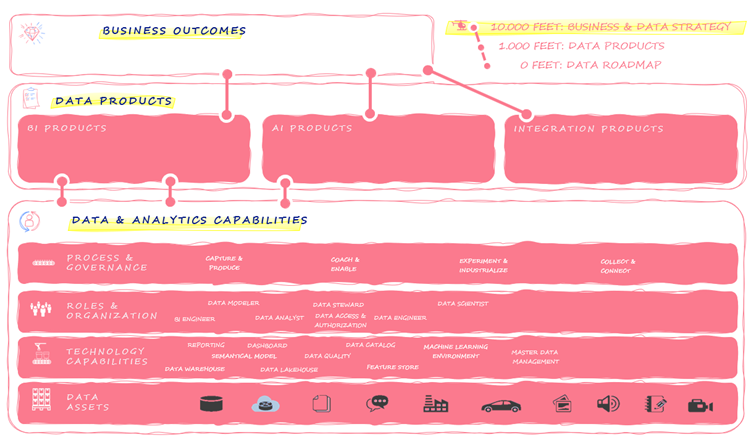Translate your data & analytics capabilities to business outcomes
In the modern business landscape, data is the cornerstone of innovation and strategic decision-making. At Plainsight, we understand the critical role that data and analytics play in driving business outcomes. Our comprehensive framework, illustrated in the accompanying infographic, demonstrates how we seamlessly integrate business strategy with robust data and analytics capabilities to deliver unparalleled value to our clients.
Business Outcomes: The Pinnacle of Strategy
At the highest level, our focus is on business outcomes. These outcomes represent the strategic goals that organizations strive to achieve, encompassing increased revenue, enhanced customer satisfaction, operational efficiency, and market competitiveness. By starting with a clear understanding of these desired outcomes, we ensure that every data initiative is aligned with the overarching business strategy.
Data Products: The Translators of Strategy
Moving a step down from the business outcomes, we have data products. These products serve as the tangible outputs of our data strategy and are categorized into three main types:
1. BI Products: Business Intelligence products provide critical insights through dashboards, reports, and visualizations. They empower organizations to make data-driven decisions by offering a clear view of key performance metrics.
2. AI Products: Artificial Intelligence products leverage advanced machine learning algorithms to automate processes, predict trends, and uncover hidden patterns in data. These products enable organizations to harness the power of AI for competitive advantage.
3. Integration Products: These products ensure seamless data flow across various systems and platforms, facilitating unified and coherent data ecosystems. Integration products are essential for maintaining data integrity and enabling holistic data analysis.
Data & Analytics Capabilities: The Backbone of Excellence
To support the development and deployment of data products, Plainsight focuses on building strong data and analytics capabilities. These capabilities are divided into several critical areas:
1. Process & Governance: This encompasses the policies, procedures, and standards that ensure data quality, security, and compliance. Effective governance is crucial for maintaining trust in data and ensuring its proper use.
2. Roles & Organization: A well-defined organizational structure with clearly delineated roles is essential for the successful execution of data initiatives. Key roles include Data Modeler, BI Engineer, Data Analyst, Data Steward, Data Scientist, and Data Engineer. Each role brings specialized skills and expertise to the table.
3. Technology Capabilities: The technology stack forms the backbone of data operations. Key components include reporting tools, dashboards, data warehouses, data lakehouses, semantic models, data quality solutions, data catalogs, machine learning environments, and master data management systems. These technologies enable efficient data processing, storage, and analysis.
4. Data Assets: Finally, the foundation of all data initiatives lies in the data assets themselves. These assets include structured and unstructured data from various sources such as databases, cloud services, IoT devices, social media, and more. Proper management and utilization of these assets are fundamental to deriving value from data.
A Unified Approach
The infographic illustrates how each component, from business outcomes to data assets, is interconnected. By aligning data products with business strategy and building robust capabilities, Plainsight ensures that organizations can effectively capture, produce, enable, experiment, industrialize, and connect data to drive meaningful outcomes.
At Plainsight, we are committed to guiding our clients through this journey, providing the expertise and tools needed to transform data into actionable insights and strategic advantage. Contact us today to learn how we can help your organization achieve its data-driven goals.
Want to implement this in your workflow, too?
David is a data and analytics consultant who drives business value with tailored solutions and a human touch.


